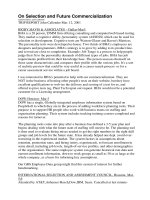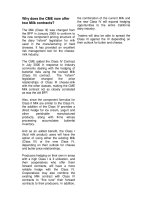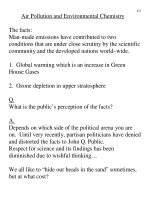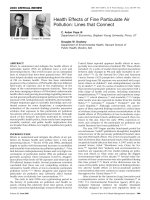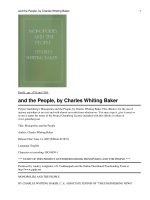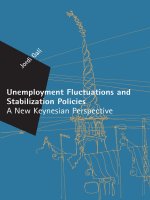fine tuning air conditioning and refrigeration systems pdf
Bạn đang xem bản rút gọn của tài liệu. Xem và tải ngay bản đầy đủ của tài liệu tại đây (1.58 MB, 129 trang )
www.EngineeringEBooksPdf.com
FINE TUNING
AIR CONDITIONING AND
REFRIGERATION SYSTEMS
BILLY C. LANGLEY
THE FAIRMONT PRESS, INC.
Lilburn, Georgia
MARCEL DEKKER, INC.
New York and Basel
iii
©2002 by The Fairmont Press. All rights reserved.
www.EngineeringEBooksPdf.com
Library of Congress Cataloging-in-Publication Data
Langley, Billy C., 1931Fine tuning air conditioning and refrigeration systems/Billy C. Langley.
p. cm.
ISBN 0-88173-385-7 (electronic)
1. Air conditioning--Efficiency. 2. Air conditioning--Maintenance and repair. 3.
Refrigeration and refrigerating machinery--Maintenance and repair. 4. Air conditioning-Design and construction. 5. Refrigeration and refrigerating machinery--Design and construction. I. Title.
TH7687.7 .L372 2001
697.9’3—dc21
2001042259
Fine tuning air conditioning and refrigeration systems/Billy C. Langley.
©2002 by The Fairmont Press. All rights reserved. No part of this publication may be
reproduced or transmitted in any form or by any means, electronic or mechanical, including
photocopy, recording, or any information storage and retrieval system, without permission
in writing from the publisher.
Published by The Fairmont Press, Inc.
700 Indian Trail, Lilburn, GA 30047
tel: 770-925-9388; fax: 770-381-9865
Distributed by Marcel Dekker, Inc.
270 Madison Avenue, New York, NY 10016
tel: 212-696-9000; fax: 212-685-4540
Printed in the United States of America
10 9 8 7 6 5 4 3 2 1
0-88173-358-X (The Fairmont Press, Inc.)
0-8247-0921-7 (Marcel Dekker, Inc.)
While every effort is made to provide dependable information, the publisher, authors, and editors cannot be held
responsible for any errors or omissions.
©2002 by The Fairmont Press. All rights reserved.
www.EngineeringEBooksPdf.com
TABLE
OF
CONTENTS
Chapter 1
Why Fine Tune Equipment?
Chapter 2
Electric Heating
Chapter 3
Gas Heating (Natural and LP)
Chapter 4
Oil Burners
Chapter 5
Air Conditioning Systems and Heat Pumps
(Cooling Mode)
Chapter 6
Heat Pumps (Heating Mode)
Chapter 7
Refrigeration
Chapter 8
Megohmmeters
Chapter 9
Pressure-Enthalpy Diagrams
©2002 by The Fairmont Press. All rights reserved.
www.EngineeringEBooksPdf.com
Chapter 10
Estimating Annual Heating Requirements
Appendix A
Air Conditioning Formulas (Non-Psychrometric)
Appendix B
Worksheets
©2002 by The Fairmont Press. All rights reserved.
www.EngineeringEBooksPdf.com
FOREWORD
This manual was written to provide the service technician with the procedures necessary to bring heating, air conditioning, and refrigeration systems, including heat pumps, to full operating efficiency. This manual was
not intended to present “standard” service procedures but rather to provide advanced information and procedures that, when followed, cause the
equipment to operate as it was designed by the manufacturer.
When used properly, the procedures presented in this manual will ensure
that the equipment operates more economically and to full capacity and
has a longer life with a minimum amount of repairs.
©2002 by The Fairmont Press. All rights reserved.
www.EngineeringEBooksPdf.com
ACKNOWLEDGMENTS
It would have been impossible to produce this manual without the help
of many manufacturers and friends who are concerned with this industry. Their contributions over the past 35 years have made a manual of this
type possible. They have been most helpful in providing information
that, in part, made this text feasible. My sincere appreciation goes to all
those companies and individuals who value this industry as much as I
do.
Billy C. Langley
©2002 by The Fairmont Press. All rights reserved.
www.EngineeringEBooksPdf.com
Why Fine Tune Equipment?
Chapter 1
Why Fine Tune
Equipment?
There are many reasons for fine tuning heating, air conditioning, and refrigeration equipment, such as energy conservation, cost ef fectiveness, less
need for new power plants, improved performance, and equipment longevity. It is true it takes more time to fine tune equipment so that it operates
at peak efficiency, and this comes at a greater cost to the customer . However, when the benefits are properly explained, most are willing to pay the
service fee, which is usually saved many times over through the more efficient and economical operation of the equipment. Also, the technician
who has the ability and desire to fine tune equipment can charge extra for
his labor and will always be in demand by the public.
ENERGY CONSERVATION
Because of the constantly decreasing sources of oil, every possible step must
be made to conserve its use. Fine tuning heating, air conditioning, and refrigeration equipment is a very good place to start, because air conditioning
units are the largest users of electricity in residential and many commercial
buildings. When heating, air conditioning, and refrigeration units are operating at peak efficiency, this percentage of power consumption is reduced
by sometimes as much as 25%. Several tests have proven that nine out of
ten heating, air conditioning, and refrigeration units are operating at a reduced efficiency that is between 10% and 40% of their rating.
COST EFFECTIVENESS
When heating, air conditioning, and refrigeration equipment is operating
properly, less energy is used and the cost of operation is reduced. Thus, the
©2002 by The Fairmont Press. All rights reserved.
www.EngineeringEBooksPdf.com
customer is saving money. When the technician fine tunes the equipment so
it operates more economically, the customer is more satisfied and is much
more pleased with the service provided. The service technician can usually
charge more for providing this fine tuning service, because the customer is
more willing to pay for good, thorough service that ensures the equipment
is operating as designed. Because of this, both parties are satisfied and the
customer is more apt to recommend the technician to others who may want
this type of service.
LESS NEED
FOR
NEW POWER PLANTS
When heating, air conditioning, and refrigeration equipment is working at
peak efficiency, power generating plants can be operated at less than full
capacity. The power company not only saves on operating expenses, but the
need to build new power plants to furnish power to inef
ficiently operating
equipment is no longer a consideration. Thus, the need for costly power
plant construction and operation is eliminated.
IMPROVED PERFORMANCE
Properly tuned heating, air conditioning, and refrigeration equipment performs better than equipment that is not properly adjusted. The customer
will be more satisfied with the operation of fine tuned equipment. In addition, the unit will keep the building more comfortable, the process refrigeration and heating equipment will satisfy the demands much more easily
, and
there will be less service and maintenance required.
EQUIPMENT LONGEVITY
Fine tuned equipment has the proper amount of refrigerant and oil flowing
through the system to maintain properly lubricated components at their desired operating temperatures. Properly lubricated equipment operating at
the desired temperature usually lasts much longer than equipment that
does not have these characteristics. Thus, the customer is saved the cost of
having to replace the equipment, and major repairs are either eliminated or
postponed to a much later date.
CHECKING PRESSURES,
TEMPERATURES, AND AIRFLOW
A check of the operating refrigerant pressures and temperatures, along with
determining the airflow through the unit and the temperature rise or drop
©2002 by The Fairmont Press. All rights reserved.
www.EngineeringEBooksPdf.com
of the air, is usually all that is needed to determine the efficiency of the unit.
The proper adjustment of one or more of these operating factors usually
determines the Btu output of the unit. Of course, the ductwork, insulation,
and the condition of the structure will determine, to a great extent, whether
or not the system will provide the desired conditions inside the building.
All of these factors must be considered when fine tuning equipment to
ensure more complete customer satisfaction. Remember , the best equipment
will not perform if it is installed poorly
. Installation is also a part of fine
tuning a unit. The unit may be operating at peak efficiency, but if the conditioned air cannot reach the space or if it is not properly distributed, the
result will still be poor operation. Give the installation a thorough inspection, and inform the customer of anything that can, or must, be done to
obtain optimum efficiency and satisfaction.
©2002 by The Fairmont Press. All rights reserved.
www.EngineeringEBooksPdf.com
Electric Heating
Chapter 2
Electric Heating
The efficiency of any unit is the relationship of the amount of heat input to
the amount of heat output. Electric heaters are considered to be 100% ef ficient. That is, for every Btu input, one Btu is delivered by the furnace.
However, this is not completely true, because some energy is always lost
when one form of energy is changed to another. But for our purposes, this
statement is accurate enough. The purpose of fine tuning equipment is to
change as much input heat as possible into heat for the building or process
being treated. The system components must be clean and in good working
condition, and clean air filters must be installed.
Electric heating units are used in both residential and commercial applications. They are available in both single- and three-phase element designs.
Because of the lower discharge air temperatures, it is important that electric
heating units operate as they were designed to prevent drafty conditions.
ADJUSTMENT PROCESS
Checking and adjusting the capacity of electric heating units is probably the
most simple procedure for all of the various types of units available. The
steps used to check the ef ficiency and capacity of electric heating units are
discussed below. There is also a worksheet at the end of this chapter with
the procedures outlined.
REQUIRED TEST INSTRUMENTS
The proper test instruments are needed to make accurate measurements of
the product being tested. The old procedure of merely looking at something
or feeling a line no longer indicates what is happening with the unit.
There are many brands and models of test instruments available. Which
particular instrument to use is the user’s choice. At any rate, accurate test
©2002 by The Fairmont Press. All rights reserved.
www.EngineeringEBooksPdf.com
instruments must be used for testing the efficiency of electric heating units.
The exact procedures for instrument use are found in the manufacturer’s
operating instructions. The instruments must be properly cared for and
their accuracy maintained for optimum performance.
This chapter will discuss the specific procedures used to fine tune electric
heating units, not specific instruments. The following is a list of the basic
test instruments required for testing and adjusting the efficiency of electric
heating units:
1.
2.
3.
Dry bulb thermometer
Ammeter
Voltmeter (a wattmeter may be used in place of the ammeter and
voltmeter)
Dry Bulb Thermometer
A dry bulb (db) thermometer is used for checking air temperatures, Figure
2-1. Determining the temperature rise of the air as it passes through the
heating unit is a very important step in the fine tuning process. The dry
bulb temperature is a measure of the heat absorbed from the heating elements by the air. The air temperature is measured in two locations: the
return air stream and the discharge air stream, Figure 2-2. Be sure to take
the temperature readings after the mixing of any air and within 6 ft of the
air handling unit.The thermometers must be placed where the radiant heat
from the elements cannot be measured by the thermometer . Radiant heat
can cause a faulty temperature reading and an incorrect test.
Two different thermometers that have been tested and found to produce
exactly the same readings under the same set of circumstances should be
used. If two thermometers that read exactly the same temperatures are not
Figure 2-1. Dry bulb thermometers (Courtesy, Dwyer Instruments, Inc.)
©2002 by The Fairmont Press. All rights reserved.
www.EngineeringEBooksPdf.com
Figure 2-2. Measuring circulating air temperature
available, then use one thermometer to measure both temperatures. An
electronic thermometer that has separate, properly adjusted leads also produces the desired results. The best operating temperature rise of an electric
heating unit is about 40° to 50 °F. This allows the blower to run longer,
distributing the air more evenly throughout the building.
Ammeter
The ammeter is used to determine the amount of electrical current used by
the unit. The clamp-on type ammeter is the most popular, because the
amperage can be measured without separating the wire. These instruments
are the most accurate when the wire being measured is in the center of the
tongs.
Voltmeter
The voltmeter is used to measure the voltage in a wire, Figure 2-3. The
analog-type meter is the most accurate when the indicator is in the center
of the scale. The leads should be checked regularly to ensure they are in
good working condition. When the insulation becomes worn or cracked,
the leads should be replaced. A firm, solid fit between the meter and the
lead must be maintained. A loose fitting lead can give an improper voltage
reading.
©2002 by The Fairmont Press. All rights reserved.
www.EngineeringEBooksPdf.com
Figure 2-3. Digital multimeters (Courtesy, AM Sperry Instruments, Inc.)
©2002 by The Fairmont Press. All rights reserved.
www.EngineeringEBooksPdf.com
Wattmeter
The wattmeter is used to measure the voltage to the unit and the total
wattage used by the unit. These instruments are usually more accurate than
the voltmeter and ammeter to determine the total wattage used by the unit.
However, wattmeters are more expensive. The analog-type wattmeter is the
most accurate when the indicator is reading at the mid-scale point.
KILOWATT INPUT
Depending on the size and type of installation, both single- and three-phase
heating elements are used. When determining the kilowatt input, be sure to
measure the total voltage and amperage to the unit, including the fan
motor, because it also adds heat to the air . When more than one heating
element is used, check the fan motor separately to prevent adding the
motor amperage to each element. The measurements should be taken at a
close disconnect switch or where the electricity enters the unit, not at a
distant point.
DETERMINING ELECTRIC HEATING UNIT CAPACITY
To determine the capacity of an electric heating unit, first determine the
watt and Btu input to the unit by performing the following steps:
1.
2.
3.
Measure the voltage and amperage to the fan motor and each heating
element.
Add together the amperage draw of each heating element and the fan
motor.
Determine the unit wattage by multiplying the voltage by the amperage. Use the following formula:
where:
4.
W
=
V x I
W
V
I
=
=
=
wattage
voltage
amperage
Determine the unit Btu output by multiplying the wattage by 3.413.
Use the following formula:
Btu
5.
=
W x 3.413
Determine the blower cfm by dividing the Btu by 1.08× 6T. Use the
appropriate formula:
©2002 by The Fairmont Press. All rights reserved.
www.EngineeringEBooksPdf.com
cfm =
Btu
1.08 × 6T
cfm = kW × 3413
1.08 × 6T
cfm = W × 3.413
1.08 × 6T
where:
1.08
6T
cfm
kW
=
=
=
=
specific heat of air constant
temperature rise
cubic feet per minute
kilowatts
Make certain that all the return and supply air grilles are open and unobstructed. If an air conditioning unit is included, make certain that the coils
and filters are clean.
6.
Determine the 6T by using the following steps:
a. Allow the unit to run continuously for about ten minutes.
b. To avoid thermometer error, use the same thermometer to measure the return and supply air temperatures.
c. Measure the temperatures at a point where the thermometer cannot “see” the heat source (see Figure 2-2). True air temperature
cannot be measured when radiant heat is sensed by the thermometer.
d. The air temperature measurements must be taken within 6 ft of
the air handling unit.The return air temperature can be taken at
the return air grille if it is located close to the unit, as in Figure 22. The air temperature taken at the supply air grille is not usually
accurate enough for this purpose.
e. When more than one discharge or return air duct is connected to
the plenum, use the average temperature (AT). For example, Duct
1 = 115 °F, Duct 2 = 110 °F, and Duct 3 = 108 °F. Use the following
formula:
AT = Duct 1 + Duct 2 + Duct 3
Number of ducts
AT = 115°F + 110°F + 108°F = 111°F
3
f.
7.
Be sure to take the temperature measurements after any source of
mixed air, such as a fresh air intake.
Check the manufacturer’s specifications for the particular unit to see
if these conditions meet the design criteria.
When the cfm is too high, slow the blower. When the discharge cfm is too
low, speed up the blower. When a direct drive motor is used, the cfm can
be changed by moving the electric wire to a lower or higher speed terminal
©2002 by The Fairmont Press. All rights reserved.
www.EngineeringEBooksPdf.com
on the motor or in the furnace wiring junction box. Check the unit wiring
diagram to make sure the correct connections are made. Otherwise, damage
to the motor could occur.
When a direct drive motor cannot be wired to deliver the correct cfm, use
the next higher speed and reduce the air inlet to the blower. Be sure to make
the reduction on the blower end opposite the motor to prevent overheating
of the motor. Adjust the baffle to deliver the correct cfm, and secure the
baffle in place. The baffle can be made from a piece of sheet metal cut and
screwed in place on the blower housing, Figure 2-4.
When a belt drive blower is used, the cfm can be changed by use of an
adjustable pulley on the motor shaft. To increase the cfm, close the pulley
halves. To reduce the cfm, open the pulley halves. Note: 6T = discharge air
temperature minus return air temperature.
When the heating unit is operating at its rated capacity but is not heating
the building sufficiently, there are other options available. First, open all of
the supply grilles, measure the cfm from each one, and total them. If the
cfm is 10% less than that determined in Steps 5 and 6 (listed previously), air
is leaking from the duct system. Find the leak and repair it.
The next step is to measure the discharge air temperature as it leaves the
supply air grille located farthest from the heating unit.The difference in
discharge air temperature at the unit and this reading should not exceed
more than 3° to 5°F. If the difference is more than 5 °F, the duct needs more
insulation.
When the duct system meets this criteria, the only other alternative is to
add more capacity. This can be done by either adding more heat strips or
installing some with higher capacity ratings.Table 2-1 lists the temperature
rise, the kW rating of the furnace, and the corresponding cfm. This information can be used to reduce the time required to get a very close estimate of
how efficient the unit is operating.
Figure 2-4. Blower inlet adjustment
©2002 by The Fairmont Press. All rights reserved.
www.EngineeringEBooksPdf.com
Table 2-1. Temperature rise in °F
©2002 by The Fairmont Press. All rights reserved.
Cfm
5 kW
7.5 kW
10 kW
12.5 kW
15 kW
17.5 kW
20 kW
300
53
—
—
—
—
—
—
400
59
79
—
—
—
—
—
500
32
47
63
—
—
—
—
600
26
39
53
—
—
—
—
700
23
34
45
57
68
—
—
800
20
30
40
49
59
69
79
900
18
26
35
44
53
61
70
1000
16
24
32
40
47
55
63
1100
14
22
29
36
43
50
57
1200
13
20
26
33
40
46
53
1300
12
18
24
30
37
43
49
1400
11
17
23
28
34
40
45
1500
—
16
21
26
32
37
42
1600
—
—
20
25
30
35
40
1700
—
—
19
23
28
32
37
1800
—
—
18
22
26
30
35
1900
—
—
17
21
25
29
33
2000
—
—
16
20
24
28
32
www.EngineeringEBooksPdf.com
Electric Heating Unit Capacity Worksheet
Introduction: When a customer complains about insufficient heat from an electric heating unit, the service technician
should, as a first step, determine if the heating elements are delivering the amount of heat they were designed to
deliver. It could be that one or more of the heating elements is not operating properly. This is a fairly simple test and
is easily performed.
Tools Needed: ammeter, voltmeter, accurate thermometer, and tool kit. An accurate wattmeter may be used in place
of the ammeter and the voltmeter.
Procedures:
1.
Turn off the electricity to any other equipment that is used in conjunction with the electric heating unit.
2.
Set the thermostat to demand heat. Allow the heater to operate for approximately 10 minutes so the temperatures will stabilize.
3.
Measure the voltage and amperage of each heating element and record:
Volts
Motor:
Amps
1.
____________________________
____________________________
Heater: 1.
____________________________
____________________________
2.
____________________________
____________________________
3.
____________________________
____________________________
4.
____________________________
____________________________
5.
____________________________
____________________________
____________________________
____________________________
Sum:
4.
Determine the total wattage of the heat strips and record. Use the following formula:
W= V × I
W = ________
5.
Determine the Btu output of the heat strips and record. Use the following formula:
Btu = W x 3.413
Btu = ________
©2002 by The Fairmont Press. All rights reserved.
www.EngineeringEBooksPdf.com
6.
Determine the cfm of the blower and record. Use the following instructions:
•
Use the same thermometer, or two that measure exactly the some, to measure the return and supply air
temperatures.
•
Do not measure the temperature in an area where the thermometer can sense the radiant heat from the
heat strips (see Figure 2-2). True air temperature cannot be measured if the thermometer senses radiant
heat.
•
Take the temperature measurements within 6 ft of the air handler. Measurements taken at the return and
supply grilles that are at too great a distance from the unit are not usually accurate enough.
•
Use the average temperature when more than one duct is connected to the supply air plenum.
•
Be sure the air temperature has stabilized before taking the temperature measurements.
•
Take the temperature measurements downstream from any source of mixed air. Use the following formula:
cfm =
Btu
1.08 × 6T
cfm = ________
7.
Is this what the manufacturer rates the equipment?
Multiple tear-out copies
of this worksheet
can be found in
Appendix B.
©2002 by The Fairmont Press. All rights reserved.
www.EngineeringEBooksPdf.com
Gas Heating (Natural and LP)
Chapter 3
Gas Heating
(Natural and LP)
The purpose of adjusting the efficiency of any piece of equipment is to
deliver the most energy possible to the conditioned space or process. The
efficiency of a gas-fired furnace or boiler is the difference between the input
and the actual amount of heat produced by the unit. The efficiency adjustment must provide the greatest gain without producing undesirable conditions. In mathematical terms, efficiency is explained as:
Efficiency =
Useful energy out
Total energy
The components must be clean and in good working condition, and clean
air filters must be installed.
ADJUSTMENT PROCESS
There are several closely related factors involved in the adjustment process.
When an adjustment is made to one of these factors, the other factors are
also affected. There is a proper order to follow when making efficiency
adjustments to gas-fired equipment. The general categories of these factors
are as follows:
•
•
•
Burner performance
Heat exchanger operation
Overall performance of the combustion process
Burner Performance
The performance of the burner plays a very important part in overall unit
efficiency. The burner is the place where gas and air are mixed in the proper
©2002 by The Fairmont Press. All rights reserved.
www.EngineeringEBooksPdf.com
proportions to gain maximum efficiency. Should something happen to upset this gas-air relationship, the unit’s ef ficiency will drop in direct proportion. Therefore, the burner must be kept clean and properly adjusted.
Heat Exchanger Operation
The heat exchanger is the component that transfers heat from the flue gases
to the circulating air. It also provides a path for the escape of flue gases to
the atmosphere. Should the flue passages become clogged with soot, lint,
scale, or any other foreign material, the flue gases cannot flow through the
passages properly. The air flowing to the burners will be reduced causing
an inefficient and hazardous flame condition. Thus, two things occur. First,
the desired amount of heat cannot be removed from the flue gases and a
very hazardous condition exists. Second, when the flue gases cannot escape
out of the unit properly
, they will flow into the building causing the occupants to become ill and perhaps even die.
Overall Performance of the Combustion Process
There are several factors that af fect the overall combustion process and
the unit’s ef ficiency, such as the amount of combustion air to the unit,
the amount of gas supplied to the burner, and the proper mixing of the
gas and air.
REQUIRED TEST INSTRUMENTS
The proper test instruments are needed to make accurate measurements of
the product being tested. The old procedure of merely looking at a component or feeling a line no longer indicates what is happening with the unit.
There are many brands and models of test instruments available. Which
particular instrument to use is the user’s choice, but accurate test instruments must be used when fine tuning gas-fired equipment. The exact procedures for instrument use are found in the manufacturer’s operating instructions. The instruments must be properly cared for and their accuracy
maintained for optimum performance.
This chapter will discuss the specific procedures used to fine tune gas-fired
heating units, not specific instruments. The following is a list of basic test
instruments required for combustion testing and adjusting the efficiency of
a gas-fired heating unit:
1.
2.
3.
4.
©2002 by The Fairmont Press. All rights reserved.
Gas manifold pressure gauge, or a U-tube manometer
Dry bulb thermometer
Flue gas temperature thermometer
Draft gauge
www.EngineeringEBooksPdf.com
5.
6.
7.
Carbon monoxide analyzer
Carbon dioxide analyzer with the appropriate combustion ef
ficiency
chart or slide rule to use in combination with the various test results
to determine combustion efficiency
Velometer and other airflow measuring instruments
Gas Manifold Pressure Gauge
The gas manifold pressure gauge is used to measure the gas pressure in the
manifold pipe just before it passes through the orifices and into the burners.
The gauge must be connected between the gas pressure regulator and the
main burner orifices, Figure 3-1.
Figure 3-1. Gas manifold pressure gauge connection
Checking the gas manifold pressure gauge must be one of the first steps
performed when fine tuning gas heating equipment, because if the heat is
not getting in, there is no way to get it out.
The gauge may be a normal type pressure gauge, which measures in inches
of water column (w.c.) or a U-tube manometer, which also measures the gas
pressure in inches of w.c. Manufactured gas should have a manifold gas
pressure of 2 to 3.5 inches w .c.; natural gas should have between 3 and 3.5
inches w.c.; and LP gas should be set at 1 1 inches w.c. Always check the unit
nameplate to ensure the manufacturer’s specifications are met.
©2002 by The Fairmont Press. All rights reserved.
www.EngineeringEBooksPdf.com
Dry Bulb Thermometer
A dry bulb (db) thermometer is a normal type thermometer used for checking air temperatures (see Figure 2-1). Determining the temperature rise of
the air as it passes through the heating unit is a very important step in the
fine tuning process. The dry bulb temperature is a measure of the heat
absorbed from the heat exchanger by the air . The air temperature is measured in two locations: the return air stream and the discharge air stream,
Figure 3-2. Be sure to take the temperature readings after the mixing of any
air. The thermometer must be placed where the radiant heat from the elements cannot be measured by the thermometer . Radiant heat can cause a
faulty temperature reading and an incorrect test.
Two different thermometers that have been tested and found to produce
exactly the same readings under the same set of circumstances should be
used. If two thermometers that read exactly the same temperatures are not
available, then use one thermometer to measure both temperatures. An
electronic thermometer that has separate, properly adjusted leads also produces the desired results. The best operating temperature rise of a gas-fired
heating unit is about 70°F. This temperature allows the blower to run
longer, distributing the air more evenly throughout the building.
Flue Gas Temperature Thermometer
This type of thermometer is used for measuring higher than normal temperatures. Generally, their range is about 200 ° to 1000 °F. They are used to
Figure 3-2. Measuring circulating air temperature
©2002 by The Fairmont Press. All rights reserved.
www.EngineeringEBooksPdf.com
measure the temperature of the flue gases in the vent system, or the stack
temperature. The flue gas temperature of a standard gas furnace or boiler
should not be more than 480 °F higher than the ambient or combustion air
temperature. The minimum flue gas temperature on a standard gas furnace
or boiler should be 350°F.
If the flue gas temperature is too high, not enough heat is being removed
from the burning gas. This may be due to low circulating airflow
, a dirty
heat exchanger , or the unit being over-fired. The causes of the problem
must be found and corrected.
The flue gas temperature of a high ef ficiency gas furnace will range from
about 100 ° to 125 °F. Check the manufacturer’s specifications for the specific
temperature range. The other combustion factors will remain the same.
Draft Gauge
The draft gauge is an instrument used for measuring small pressures. It is
used to measure the rate at which flue products are removed from the unit
heat exchanger . The reading is taken on the chimney side of the draft
diverter, Figure 3-3.
A negative pressure reading indicates that there is suf ficient air movement
through the combustion zone to allow proper and complete combustion. If
the reading is past the halfway point on the negative side of the scale, there
is too much draft through the unit causing excess heat to be drawn out of
the unit and inefficient operation. When the hand approaches zero or goes
to the positive side of the scale, there is too little draft through the unit and
an insufficient amount of combustion air is being drawn into the combus-
Figure 3-3. Checking vent draft
©2002 by The Fairmont Press. All rights reserved.
www.EngineeringEBooksPdf.com


